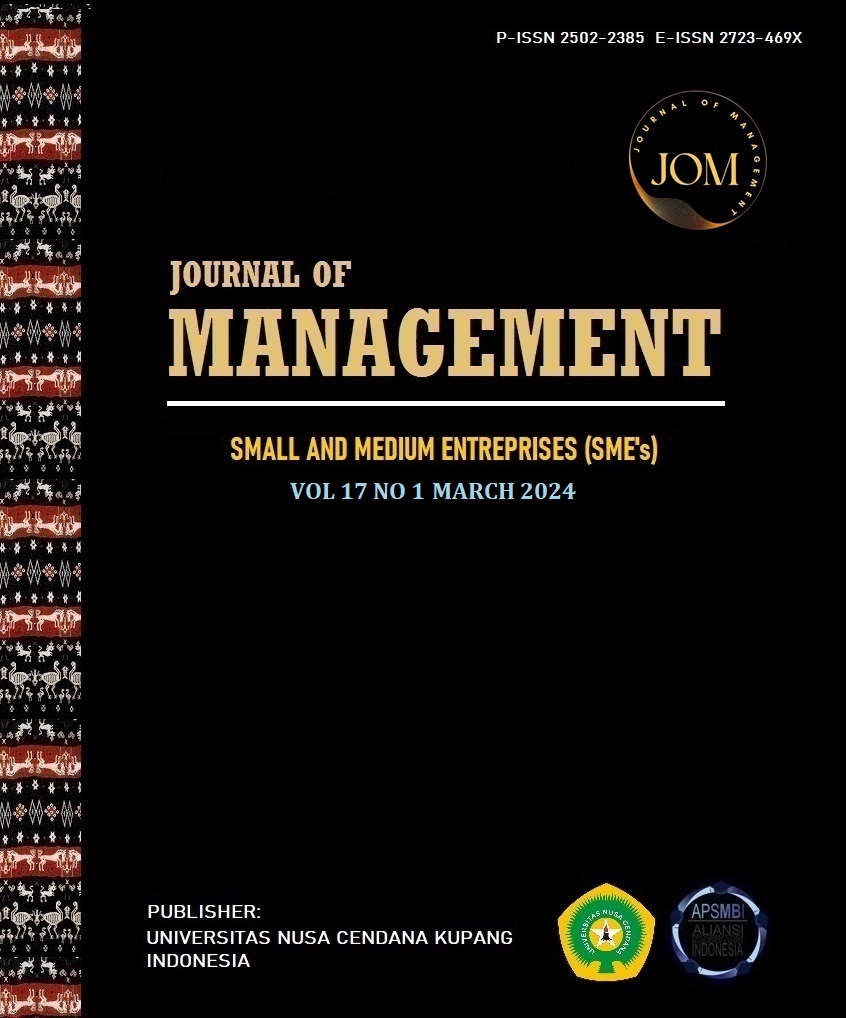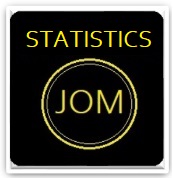URGENSI EVENT IMAGE DAN TOURISM EXPERIENCE DALAM MENCIPTAKAN REVISIT INTENTION PADA DESA WISATA KABUPATEN SUMENEP
Abstract
This research was motivated by a decrease in the number of visitors to the Kedatim Mangrove Tourism, Sumenep Regency. This research aims to determine the influence of event image and tourism experience on the intention to visit again, both directly and through the intervening variable of tourism satisfaction at Kedatim Mangrove Tourism. The sampling technique used was purposive sampling with a total sample of 100 visitors. The data collection technique was carried out by distributing questionnaires to respondents. The data analysis technique used is Partial Least Square. The research results show that event image (X1) does not have a significant effect on intention to revisit. Tourist experience (X2) has a significant effect on the intention to visit again. The image of the event (X1) has a significant effect on tourism satisfaction. Tourist experience (X2) has a significant effect on tourist satisfaction. Tourist satisfaction (Z) does not affect interest in returning to visit. Event image (X1) has no significant effect on the intention to revisit through tourism statistics. Tourist experience (X2) does not have a significant effect on the intention to visit again through tourism satisfaction.
Keywords: Event Image; Tourism Experience; Tourism Statisfaction; Revisit Intention
Downloads
References
Ahsanah, U., dan Artanti, Y, (2021), The Role of Memorable Tourism Experiences in the Relation between City Image and Visitor Engagement Toward ReVisit Intention to Yogyakarta City. Jurnal Manajemen Bisnis, 12(1), 56–70.
Al-Dweik, M. R. (2020). Influence of Event Image and Destination Image on Visitor Satisfaction and Intentions to Revisit. African Journal of Hospitality, Tourism and Leisure, Vol. X(X).
Anton, C., Camarero, C., & Laguna. (2017). Towards a New Approach of Destination Loyalty Drivers Statisfaction Visit Intensity and Tourism Motivations. Current Issues In Tourism, Vol. 20(3), 238-260.
Bigne, J., Sanchez, M. & Sanchez, J. (2001). Tourism image, evaluation variables and after purchase behaviour: Inter-relationship. Tourism Management, 22(6), 607–616.
Cakici, A. C., Akgunduz, Y., & Yildirim, O. (2019). Theimpact of perceived price justice and satisfaction on loyalty: the mediating effect of revisit intention. Tourism Review, 74(3), 443–462.
Cetin, G., Kizilirmak, I., & Balik, M. (2017). The Superior Destination Experience. Journal of Tourismology, Vol.3(2).
Chien, M. C. (2016). An empirical study on the effect of attractiveness of ecotourism destination on experiential value and revisit intention. Applied Ecology and Environmental Research, 15(2), 43–53.
Ghozali, I. (2018). Model Persamaan Struktural Konsep Dan Aplikasi Dengan Program AMOS 24. Semarang: Badan Penerbit Universitas Diponegoro.
Hallmann, K. & Breuer, C. (2010). Image fit between sport events and their hosting destinations from an active sport tourist perspective and its impact on future behaviour. Journal of Sport and Tourism, 15(3), 215–237.
Hanif, A., Kusumawati, A., & Mawardi, M. (2016). Pengaruh Citra Destinasi terhadap Kepuasan Wisatawan serta Dampaknya terhadap Loyalitas Wisatawan. Jurnal Administrasi Bisnis S1 Universitas Brawijaya, 38(1), 44– 52.
Hussein, A. S. (2016). How Event Awareness, Event Quality and Event Image Creates Visitor Revisit Intention?: A Lesson from Car free Day Event. Proedia Economics and Finance, Vol. 36 page 396-400.
Imanda, M. R & Anandya, D. (2020). Pengaruh Event Image, Destination Image, Past Experience Dan Participant Satisfaction Terhadap Revisit Intention Pada Marathon Event Di Indonesia. Jurnal Muara Ilmu Ekonomi dan Bisnis, Vol. 4(2).
Isaac, R. K., & Eid, T. A. (2018). Tourists’ destination image: An exploratory study of alternative tourism in Palestine. Current Issues in Tourism, 22(12), 1499–1522.
Jamu, M. E., Laga, Y., & Laga, Y. (2020). Pengaruh Experiential Marketing Dan Tourist Satisfaction Terhadap Revisit Intention Tourism Di Danau Kelimutu. Jurnal Manajemen Bisnis Krisnadwipayana, 8(1).
https://doi.org/10.35137/jmbk.v8i1.386
Kaplanidou, K. & Gibson, H. J. (2012). Event image and traveling parents’ intentions to attend youth sport events: A test of the reasoned action model. European Sport Management Quarterly, 12(1), 3–18.
Kim, J. H., dan Ritchie, J. R. B. (2014). Cross-cultural validation of a memorable tourism experience scale (MTES). Journal of Travel Research, Vol.53 No.3, pp. 323–335.
Kim, J. (2017). The Impact of Memorable Tourism Experiences on Loyalty Behaviors: The Mediating Effects of Destination Image and Satisfaction. Journal of Travel Research. Vol. 57, 856-870.
Li, H., Lien, C. H., Wang, S. W., Wang, T., & Dong, W. (2020). Event and city image: the effect on revisit intention. Tourism Review, June. https://doi.org/10.1108/TR-10-2019-0419.
Marcussen, C. H. (2011). Determinants of Tourist Statisfaction And Intention to Return. Tourism : An International Interdiciplinary Journal, Vol. 59(2), 203-211.
Mei, X.Y. (2014). Boring and expensive: The challenge of developing experience-based tourism in the Inland region, Norway. Tourism Management Perspectives, Vol.12, pp. 71–80.
Neal, J. D., & Gursoy, D. (2008). A Multifaceted Analysis of Tourism Statisfaction. Journal of Travel Research, Vol. 47(1), 53-62.
Paisri, W., Ruanguttamanun, C., & Sujchaphong, N. (2022). Customer experience and commitment on eWOM and revisit intention: A case of Taladtongchom Thailand. Cogent Business and Management, 9(1).
https://doi.org/10.1080/23311975.2022.2108584
PII. (2023). Magnet Baru Pariwisata Danau Toba. Portal Informasi Indonesia. https://indonesia.go.id/kategori/budaya/6832/f1-powerboat-magnet-baru-pariwisata-danau-toba?lang=1
Prebensen, Nina K, Chen, Joseph S, dan Uysal, Muzzafer S. (2018). Creating Experience Value in Tourism. London, Uk: CAB international.
Rageh et al. (2013). Using Netnography Research Method To Reveal The Underlying Dimensions Of The Customer/Tourist Experience. An International Journal, Vol. 16(2), 126 – 149.
Ramukumba, T. (2017). An evaluation of festival activities as motives for festival attendance: A case study of strawberry festival at the redberry farm in George, South Africa. African Journal of Hospitality, Tourism and Leisure, 6(4), 1–12.
Schmitt, B. H. & Rogers, D. (2015). Handbook On Brand And Experience Management. Bodmin :MPG Books.
Severt, D., Wang, Y., Chen, P. J. & Breiter, D. (2007). Examining the motivation, perceived performance, and behavioral intentions of convention attendees: evidence from a regional conference. Tourism Management, 28(2), 399–408.
Sharma, P. & Kumar, N. J. (2019). Examining event image as a predictor of loyalty intentions in yoga tourism event: A mediation model. Journal of Convention and Event Tourism, 20(3), 202–223.
Som, A. P. M., Marzuki, A., & Yousefi, M. (2012). Factors influencing visitors’ revisit behavioral intentions: A case study of Sabah, Malaysia. International Journal of Marketing Studies, 4(4), 39.
Sotiriadis, M. (2017). Experiential Dimensions and Their Influence On Behavioral Intentions Within The Context Of Nature-Based Tourism. Tourism and Hospitality Management, Vol. 23, No. 1, pp. 35-50.
Tamimi, M. (2023). Merawat Hutan Mangrove Kedatim : Ekosistem Pulih, Desa pun Punya Sumber Pendapatan. Diakses dari https://www.mongabay.co.id/2023/04/16/merawat-hutan-mangrove-kedatim-ekosistem-pulih-desa-pun-punya-sumber-pendapatan/, pada tanggal 20 Juli 2023.
Tjiptono, F. (2012). Strategi Pemasaan (3rd). Yogyakarta : Andi Offset.
Viviers, P.A. & Slabbert, E. (2014). Should arts festivals focus on push or pull factors in marketing efforts? African Journal of Hospitality, Tourism and Leisure, 3(2), 1–18.
Widagyo, K. G. (2017). Pemasaran : Daya Tarik Ekowisata dan Minat Berkunjung Wisatawan. Esensi : Jurnal Bisnis dan Manajemen, 7(2), 261-276.
Wiratini, M. N. N. A., Setiawan, N. D., & Yuliarmi, N. N. (2018). Analisis Faktor-faktor Yang Mempengaruhi Niat Kunjungan Kembali Wisatawan pada Daya Tarik Wisata di Kabupaten Bandung. E-Jurnal Ekonomi dan Bisnis Universitas Udayana, Vol. 1.
Zolfani, S.H., Sedaghat, M., Maknoon, R & Zavadskas, E.K. (2015). Sustainable tourism: a comprehensive literature review on frameworks and applications. Economic Research-Ekonomska Istraživanja, Vol 28(1), 1–30.

 Silvia Rahma Yulistira(1*)
Silvia Rahma Yulistira(1*)



